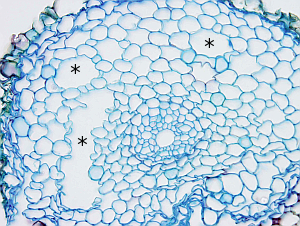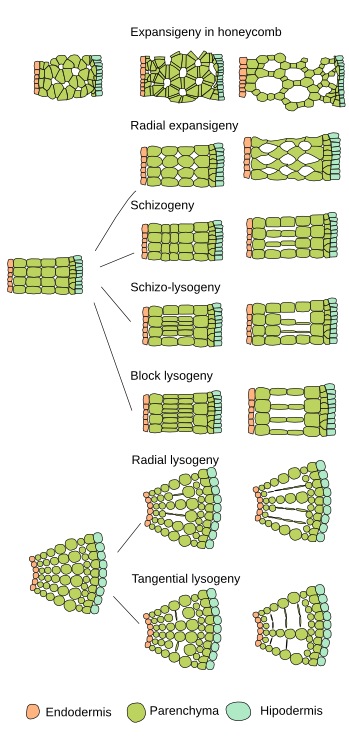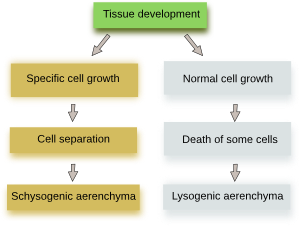The parenchyma is a metabolically active living tissue and the main component of the ground tissues, which include parenchyma, colenchyma, and sclerenchyma. Parenchyma may be up to 90 % of the tissues of herbaceous plants. It is a non-complex tissue involved in many functions depending on its location, such as photosynthesis, storage, synthesis and processing of many substances, and tissue repair. Parenchyma cells can be found in all plant systems. They form continuous groups of cells in the cortex and medulla of stems and roots, are essential components of vascular tissues, and form the leaf mesophyll, the fleshy tissue of fruits, and the endosperm of seeds (Figure 1). Parenchyma fills regions between and within other tissues. A large part of the tissue regenerative capability of plants is underpinned by the parenchyma cell properties.

In this tissue, only the parenchyma cell type is present, which commonly shows a thin primary cell wall. However, there are examples of parenchyma cells with thick cell walls, such as the palm and persimmon endosperm. Parenchyma cells are morphologically diverse, which is related to their functions. They show a lower differentiation state than other plant cells, and they therefore may be regarded as the precursors of the rest of the plant cells during evolution. There are extracellular spaces between parenchyma cells that facilitate the circulation of gases. Parenchyma cells may be generated from almost every meristem of the plant.
The parenchyma cell is able to dedifferentiate and become a totipotent cells that starts a meristematic activity. Parenchyma cells are the main cell type responsible for wounded tissue repair. Another example of parenchyma cell dedifferentiation is the formation of part of the vascular cambium meristem from the interfascicular parenchyma of dicot stems when the secondary growth begins. In addition, this property makes parenchyma cells an excellent source to produce callus, an in vitro mass of undifferentiated cells that proliferate and differentiate to give rise a complete adult plant.
There are four types of parenchyma according to their function:
1. Chlorophyll parenchyma

This type of parenchyma, also known as chlorenchyma, is specialized in photosynthesis thanks to the many chloroplasts present in their cytoplasm. Chlorophyll parenchyma is commonly found under the epidermis, where light is more intense, and it is abundant not only in leaves but also in the cortex of green stems. The chlorophyll parenchyma of the leaves is known as mesophyll, which is usually divided into two types: palisade and spongy mesophyll. Palisade mesophyll is close to the upper epidermis of the leaves, where it gets more light, while the spongy mesophyll is on the lower and darker side of the leaves. Parenchymatic cells of the palisade mesophyll are more tightly packaged and contain more chloroplasts, so the photosynthetic activity is higher. In the spongy mesophyll, there are more empty intercellular spaces that facilitate the movement of gases and water vapor.
2. Storage parenchyma

The cells in this tissue synthesize and store a number of substances. Although these substances can be solid, like starch grains and crystallized proteins, they are mostly found in solutions, such as lipids, proteins, and pigments. Usually, they are stored in the vacuole, which is the compartment specialized for storing molecules. Some molecules, like carbohydrates and nitrogen-containing substances, are also stored in the cytosol and plastids. Some parenchyma cells store only one type of substance, but a mix of different substances can also be found. Despite the fact that the cell wall of the parenchyma cell is thin, storage parenchyma cells in some seeds may show a very thick cell wall because they are able to store carbohydrates (as hemicellulose) in their cell wall.
The most common stored substances in vegetative organs are carbohydrates. They are found in two forms: starch and sucrose, or sucrose derivatives (mostly fructanes). Starch is stored in plastids (known as amyloplasts), while the sucrose forms are found in the vacuole. Stored proteins are a source of nitrogen, a very scarce element for plant cells, after they are metabolized. Proteins and lipids can be stored in parenchyma cells of many seeds, especially in dedicated plastids known as proteinoplasts and elaioplasts, respectively. In seeds, lipids are stored as triglycerides. Tannins and anthocyanins are stored in some plant tissues. The color of flowers is because of the accumulation of pigments in plastids (chromoplasts) and vacuoles.
The distribution of the storage parenchyma is widespread in the plant body. It can be found in roots, stems, leaves, seeds, and fruits. For instance, sugarcane and potatoes (Figure 2) store carbohydrates in the stem parenchyma, whereas carrots do it in the root. Another place to store substances is the parenchyma that forms the rays of the vascular system, which are needed during the winter. Seeds and fruits are organs with a large proportion of storage parenchyma.

3. Aquiferous parenchyma

Although all parenchymatic cells store some amount of water, those of the aquiferous parenchyma are specialized in this function. They are large cells with a thin cell wall and a very large vacuole, where water is stored. Their cell walls are able to fold and unfold to alternate between dry and wet periods. This ability prevents the destruction of the cell. A dry environment modifies the cell wall by changing its molecular components, namely pectin, hemicellulose, and proteins such as expansins. The larger amount of water is stored within the cells (simplast). However, some species may store water in the intercellular spaces (apoplast), where a polysaccharide substance known as mucilage can retain the water.
Water-storing cells may be just doing this function (hydrenchyma), or they may perform photosynthesis too. If they perform photosynthesis, chloroplasts are close to the plasma membrane. The small organs of the plant specialized in storing water do not usually contain structural elements. The water pressure is the mechanical supporting force. It makes it easy for them to shrink during the dry season. However, large organs that store water show supporting structures that still allow some volume changes.
The aquiferous parenchyma is characteristic of plants living in dry environments. These plants are known as xerophytes. The underground organs specialized in storing substances do not commonly contain water-storing tissues, although parenchyma cells storing starch or other substances usually contain a large amount of water as well.
4. Aeriferous parenchyma

Aeriferous parenchyma, or aerenchyma, is a tissue with large interconnected empty intercellular spaces, larger than those found in other tissues, through which gases can diffuse and aerate the organs (Figure 3). This tissue allows aquatic plants to float and keeps them near the surface for more efficient photosynthesis.

This tissue is well-developed in plants living in wet or aquatic environments (these plants are known as hydrophytes), although it can also be found in non-aquatic plants under stress. Both stem and root can develop aerenchyma. In the roots, two ways of aerenchyma formation have been observed: schizogeny and lysogeny. Schizogeny is a process that occurs by cell differentiation during the development of the organ. Lysogeny is a consequence of the stress, and the intercellular cavities are produced by cell death. Lysogenic aerenchyma is found in wheat, rice, corn, and barley. Nitric oxide and ethylene are involved in the regulated cell death to form aerenchyma during periods of shortage in oxygen. Some authors suggest a third type known as expansigeny, where the intercellular cavities are formed by cell retraction but cells do not lose the physical contacts (Figures 4 and 5).


The aerenchyma is continuous from the stem to the root. The large empty spaces of the tissue allow the movement of gases, increasing the conduction from the leaves to the roots. This communication is vital for plants living in aquatic environments or wet soils for keeping the level of oxygen normal for the respiration of root cells. It is also a way for releasing gases, like ethylene, from the roots to the environment. Aerenchyma is seen as an adaptation of the plants to hypoxia in wet or flood soils.
Plants having aerenchyma are regarded as major players in the release of greenhouse gases to the atmosphere, such as methane, for they can capture these gases from the soil and funnel them through the roots, shoots, and leaves. This mechanism is particularly intense in extensive crops like rice.
5. Other parenchyma cells
As mentioned before, there are parenchyma cells in other tissues. In the secondary vascular tissues, the xylem and phloem rays are parenchyma cells specialized in transporting and storing substances. In the phloem, the companion cells are parenchyma cells associated with conducting cells to nurture the sieve tubes.
Some parenchyma cells are specialized in the secretion of substances, including water, salts, volatile molecules, carbohydrates, digestive enzymes, and defensive substances. All these cells are classified as secretory parenchyma. Other parenchyma cells form barriers for diffusion, such as the endodermis, exodermis, and part of the periderm. The exodermis is present in the roots of many angiosperms, just below the epidermis, and develops a cell wall similar to the endodermis cells. The function of the exodermis is to prevent the water loss. Pheloderm is a parenchyma layer of the periderm found below the cork cambium.
 Meristems
Meristems